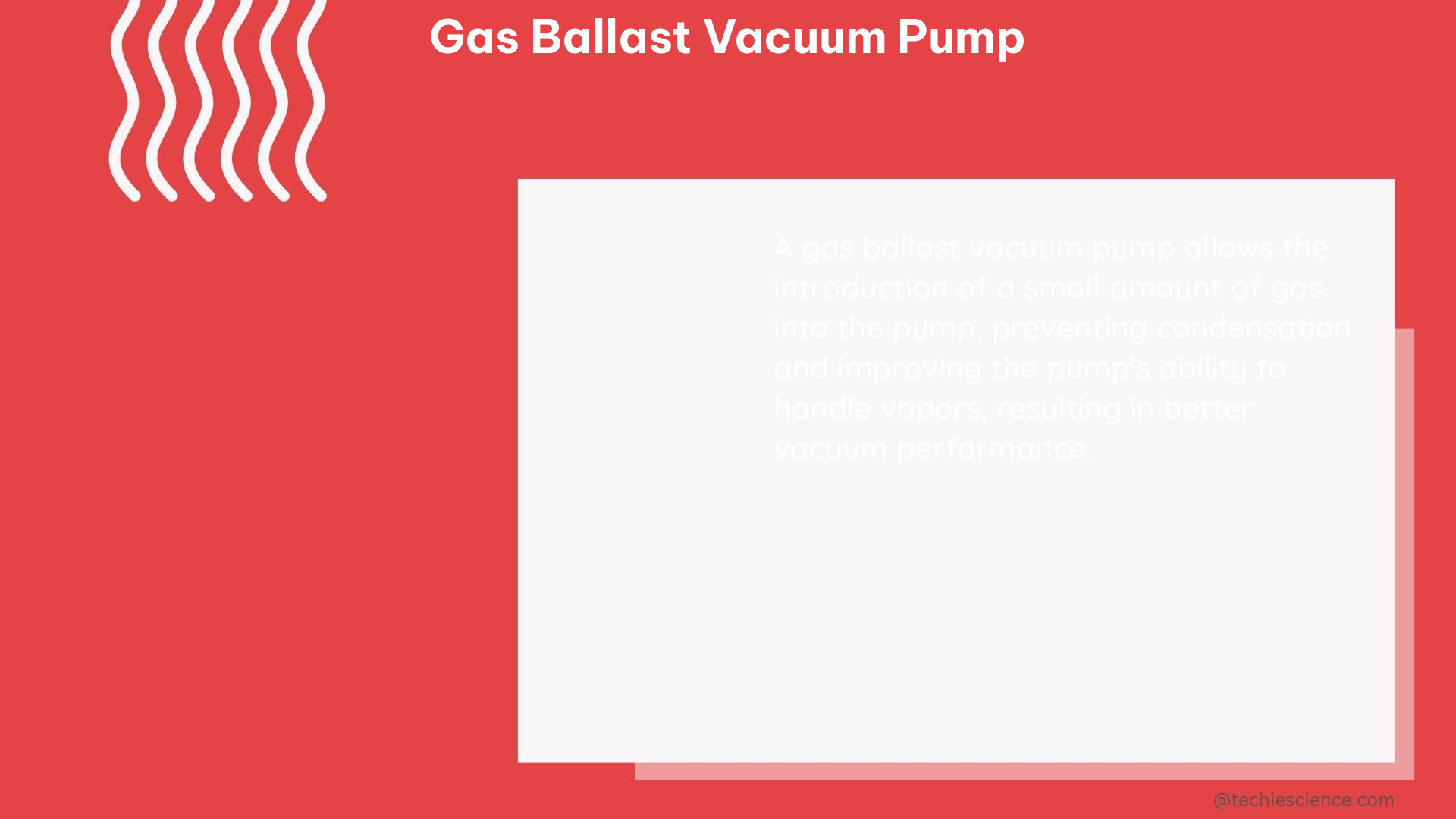A gas ballast vacuum pump is a specialized type of vacuum pump that incorporates a gas ballast feature to enhance its performance and prevent oil contamination when handling condensable vapors or moisture. This feature allows a controlled amount of atmospheric air to enter the pump, reducing the likelihood of vapor condensation and extending the lifespan of the pump oil. Whether you’re a DIY enthusiast or a professional in the field, this comprehensive guide will equip you with the technical know-how to understand and optimize the performance of your gas ballast vacuum pump.
Understanding the Pumping Speed and Ultimate Pressure
The pumping speed of a gas ballast vacuum pump is a crucial specification that determines the pump’s ability to evacuate a system. This parameter is typically measured in cubic feet per minute (CFM) or liters per minute (L/min) and can vary depending on the pressure range. For example, the Welch Vacuum rotary vane pump has a pumping speed of 12.8 CFM (362 L/min) at 133 to 1013 mbar (1 to 100 kPa) without gas ballast, and 11.9 CFM (337 L/min) at 133 to 1013 mbar (1 to 100 kPa) with gas ballast at 60 Hz.
The ultimate pressure, on the other hand, is the lowest achievable pressure in the pumped volume, and it is typically measured in millibars (mbar) or torr. The Welch Vacuum rotary vane pump, for instance, has an ultimate pressure of 3×10^-4 mbar (2×10^-4 Torr) without gas ballast and 1×10^-2 mbar (7.5×10^-3 Torr) with gas ballast. Understanding these technical specifications is crucial in selecting the right gas ballast vacuum pump for your application.
The Importance of the Gas Ballast Valve

The gas ballast valve is a critical component of a gas ballast vacuum pump, as it allows a controlled amount of atmospheric air to enter the pump. This feature is particularly useful when handling wet or corrosive systems, as it helps prevent vapor condensation and oil contamination. The position and adjustment of the gas ballast valve can significantly impact the pump’s performance, and it’s essential to understand how to optimize its usage based on the specific application.
Maximizing Pump Performance and Longevity
To ensure optimal performance and longevity of your gas ballast vacuum pump, it’s essential to follow a few key maintenance practices:
-
Regular Oil Checks and Changes: Regularly check the pump oil level and quality, and change the oil as recommended by the manufacturer. This will help maintain the pump’s efficiency and extend its lifespan.
-
Proper Gas Ballast Usage: Use the gas ballast feature when handling wet or corrosive systems to prevent oil contamination and maintain pump performance. Adjust the gas ballast valve as needed to optimize the pump’s operation.
-
Leak Testing: Perform leak testing before and after using the pump to ensure system integrity and prevent pump damage. This will help identify and address any potential leaks that could compromise the pump’s performance.
-
Moisture Removal: When pumping wet systems, consider using a cold trap to remove moisture and protect the pump oil from contamination. This can help extend the oil’s lifespan and maintain the pump’s efficiency.
Technical Specifications and Comparison
To help you make an informed decision when selecting a gas ballast vacuum pump, here’s a comparison of the technical specifications of some popular models:
| Pump Model | Pumping Speed (CFM/L/min) | Ultimate Pressure (mbar/Torr) |
|---|---|---|
| Welch Vacuum Rotary Vane Pump | 12.8 CFM (362 L/min) without gas ballast 11.9 CFM (337 L/min) with gas ballast |
3×10^-4 mbar (2×10^-4 Torr) without gas ballast 1×10^-2 mbar (7.5×10^-3 Torr) with gas ballast |
| Edwards RV12 Rotary Vane Pump | 12.7 CFM (360 L/min) without gas ballast 11.8 CFM (335 L/min) with gas ballast |
2×10^-4 mbar (1.5×10^-4 Torr) without gas ballast 8×10^-3 mbar (6×10^-3 Torr) with gas ballast |
| Agilent IDP-3 Dry Scroll Pump | 3.1 CFM (88 L/min) without gas ballast 2.9 CFM (82 L/min) with gas ballast |
5×10^-4 mbar (3.8×10^-4 Torr) without gas ballast 5×10^-3 mbar (3.8×10^-3 Torr) with gas ballast |
Remember, these specifications may vary depending on the manufacturer, model, and operating conditions, so it’s essential to consult the product documentation or technical support for the most up-to-date and accurate information.
Conclusion
Gas ballast vacuum pumps are a versatile and essential tool for a wide range of applications, from scientific research to industrial processes. By understanding the technical specifications, the importance of the gas ballast valve, and the best practices for maintenance and operation, you can ensure that your gas ballast vacuum pump delivers optimal performance and longevity. Whether you’re a DIY enthusiast or a professional in the field, this comprehensive guide has provided you with the knowledge and insights to become a true master of gas ballast vacuum pump technology.
References
- JB Industries, “Vacuum Pump FAQs – JB Industries”, https://www.jbind.com/faq/
- VACUUBRAND, “How to test the vacuum of your pump – VACUUBRAND”, https://www.vacuubrand.com/news/bloguebersicht/checking-the-functionality
- Reddit, “Is gas ballast necessary for vacuum pump? : r/Chempros – Reddit”, https://www.reddit.com/r/Chempros/comments/17j86fs/is_gas_ballast_necessary_for_vacuum_pump/
- HVAC-Talk, “Vacuum pump ballast question – HVAC-Talk”, https://hvac-talk.com/vbb/threads/2012051-Vacuum-pump-ballast-question
- Welch Vacuum, “Rotary vane pumps – Welch Vacuum”, https://www.welchvacuum.com/content/published/api/v1.1/assets/CONTB28AE02DCEB9412C9018479723FE1ED3/native/crvpro-162430-manual?channelToken=eb61187e9f2f44d599fe30b9cda88022
- Edwards Vacuum, “RV Series Rotary Vane Pumps – Edwards Vacuum”, https://www.edwardsvacuum.com/products/rv-series-rotary-vane-pumps
- Agilent Technologies, “IDP-3 Dry Scroll Pump – Agilent”, https://www.agilent.com/en/product/vacuum-technologies/dry-scroll-pumps/idp-3-dry-scroll-pump

The lambdageeks.com Core SME Team is a group of experienced subject matter experts from diverse scientific and technical fields including Physics, Chemistry, Technology,Electronics & Electrical Engineering, Automotive, Mechanical Engineering. Our team collaborates to create high-quality, well-researched articles on a wide range of science and technology topics for the lambdageeks.com website.
All Our Senior SME are having more than 7 Years of experience in the respective fields . They are either Working Industry Professionals or assocaited With different Universities. Refer Our Authors Page to get to know About our Core SMEs.